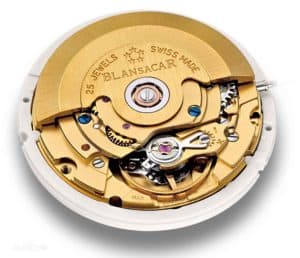When you are starting your watch company, the first step would be creating your watch designs. As the watch movement is regarded as the heart of a watch, it is very important to satisfy your clients with selling them a durable watch which always a key to bring loyalty buyers.
However there are many movements out there, the common used watch movements are from Switzerland and Japan, but how to select the right movement for your watches?
As an OEM watch manufacturer, we will provide more information of their difference, so you can get more idea on how to select.
Price
The price of Swiss movement is cost pretty more than Japanese movement. Since the Japanese movements are assembled by automated robotics, the cost is fairly low than the Swiss movement. With a same feature, the price of Japanese movement is half less than Swiss movement.
Movement Battery Life
When it comes to battery life, we are talking about the quartz movement. The battery life of movements manufactured by Miyota is usually 3~5 years, but the battery life is 5~10 years of Swiss quartz movement, such as Ronda movement.
Battery life is an important feature of your watches, as it can bring better experience to the clients and a good marketing detail.
Time Accuracy
As we mentioned above, the Japanese movement is assembled by automated robotics, therefore there is less error caused by human, which means the accuracy of Japanese movement is working better than Swiss movement in principle, but it also results in a less detailed, more “raw” look, while Swiss movements are more focused on the craftsmanship. This is relating to the aesthetics we are going to talk next.

For quartz watches, they are all assembled by robotics, so you don’t worry about the accuracy when you are considering to use a Swiss quartz movement.
Craftsmanship
Due to Swiss movement focus on the craftsmanship, the movement is much more aesthetically designed than Japanese movement. Especially when the watch has a transparency back, people can see through the movement. Or when you open the watch back when you try to repair a watch, you will find the big difference of the craftsmanship between this two movements.

How to select the movements
As mentioned above, Japanese movements are considered very practical, with more emphasis on precision and a cost-effective build, and less on looks. These movements are created on automated assembly lines, which helps keep costs down for manufacturers.
When you get limited budget and stick to high quality watches, then you are recommended to use Japanese movement. For example, as a micro watch brand, most of San Martin watches are with Seiko NH35 and Miyota 9039 movements, which make their price is very aggresive.
However Swiss made is a symbol of highest quality watches, they set the standard for both precision and quality. Swiss movements must adhere to certain laws that ensure excellence and accuracy and are also most often hand-assembled — a detail which usually impacts the overall quality (and price) of the watch.
If you are not nervous about your budget, and want to create a very high end watch at a high retail price, then Swiss movements must be your first choice.
[…] These five manufacturers are the main player of Swiss watch movement manufacturers. And then the Japanese movement manufacturers, if you are wondering what’s the difference between Japanese movement and Swiss movement, you can read more there. […]